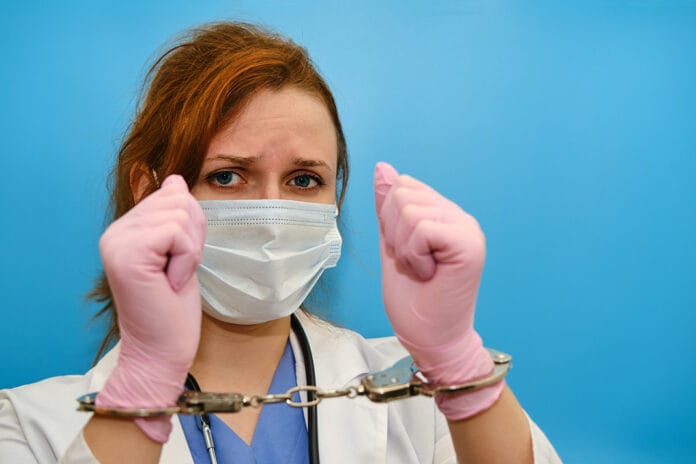Nurses and nurse practitioners across the country closely followed the RaDonda Vaught case. Vaught was a registered nurse working at Vanderbilt University Medical Center. She was criminally charged and convicted of two felonies in March, potentially facing eight years in prison due to a medical error that resulted in the death of a patient.
The case set a new precedent for health care workers being criminally charged for a medical error. Though this is a rare case, there are important lessons to be learned.1
According to court documents and Vaught’s disciplinary hearing, she admits to her mistake in administering the wrong medication, which resulted in the patient’s death.2 She also admits to becoming “complacent” in her job and “distracted” by another employee.3
Though dental hygienists are rarely present in a hospital setting and likely never administer drugs like the ones discussed in this case, the fact that Vaught admittedly states she was “complacent” and “distracted” is something most hygienists can relate to in their daily tasks. This is a dangerous mindset for all health care professionals ‒ a recipe for an error that could lead to a medical emergency, potentially ending in the death of a patient.
Additionally, Vaught was thrown under the bus by all of her superiors. Though Vanderbilt was determined to “bear heavy responsibility” in the death of the patient, no one besides Vaught was criminally charged.4 Not only did Vanderbilt bear a heavy responsibility, but her superiors, such as the charge nurse and the prescribing doctor, were not named in this case, nor did they come to her defense.
Liability
No dental hygienist or respectable health care professional sets out to intentionally harm a patient, but mistakes are made. It highlights the fact that we are all human, and to err is human. When considering health care providers such as registered nurses and dental hygienists, historically, these mistakes have fallen to the dentist or doctor overseeing the care of the patient.
Though available to dental hygienists, malpractice insurance is mostly possessed by the dentist. This is a gross misunderstanding on the part of hygienists as hygienists can be named in a suit without the dentist being named, making the hygienists liable. The Vaught case highlights the possibility that health care professionals overseeing the care and managing lower-level providers can avoid being held liable.
For this reason, dental hygienists should maintain their own malpractice insurance. In short, dentists are not obligated to protect you in a civil or criminal suit. Dental hygienists can and have been culpable of malpractice with rewards up to $999,999.5
Medical Errors in Dentistry
Some of you may be thinking, “RaDonda Vaught’s case isn’t applicable to dentistry.” I would like to suggest it certainly is, without question. RaDonda Vaught became complacent and distracted by her own admission. I think we can all agree this happens in dental settings more often than many of us would like to admit. That alone makes the case applicable, but I would like to take it a step further and discuss areas of dental hygiene that are often neglected due to complacency, distractions, lack of appropriate staffing, and limited time available to treat patients properly. These things are the ingredients in what can quickly become a medical error in a dental setting.
Failure to diagnose, misdiagnosis, and failure to refer are all considered medical errors.6 The failure to diagnose periodontal disease is by far the most important and applicable to dental hygienists. This often occurs because hygienists are either complacent or limited on time, rendering them unable or unwilling to properly document the periodontal status of patients through complete periodontal charting. I’m sure many hygienists feel that not diagnosing periodontal disease isn’t quite as serious as administering the wrong medication that results in a patient’s death.
However, I would like to suggest that it is just as detrimental. Consider the situation with Vaught, as her error was clear very quickly, and the resulting death of her patient was evident. Failing to diagnose periodontal disease ‒ a disease well established behind the onset and progression of cardiovascular disease, Alzheimer’s disease, and multiple cancers ‒ may ultimately be a contributing factor in the death of your patient.
This won’t be quite as evident as the death of RaDonda Vaught’s patient since the periodontally involved patient will take years to deteriorate in most cases. However, that does not remove culpability. Furthermore, neglecting to refer patients to periodontists when their disease warrants a referral is another medical error often associated with complacency.
Failure to pursue and accurately acquire imaging of patients is a medical error, and don’t be fooled into believing those refusal forms will protect you because they won’t.6 Many hygienists cite patient autonomy regarding their right to refuse radiographs.
A portion of the American Dental Association’s statement regarding the principle of patient autonomy should be highlighted: “This principle expresses the concept that professionals have a duty to treat the patient according to the patient’s desires, within the bounds of accepted treatment, and to protect the patient’s confidentiality. Under this principle, the dentist’s primary obligations include involving patients in treatment decisions in a meaningful way, with due consideration being given to the patient’s needs, desires and abilities, and safeguarding the patient’s privacy.”7
The important part of this statement is highlighted in bold, “within the bounds of accepted treatment.” This is an important aspect of the principle as it allows patients to make choices, but not if it puts the provider at risk of being negligent, which could result in a medical error. This is an ethical dilemma that is difficult to navigate in many instances. The dilemma is that two ethics ‒ patient autonomy and nonmaleficence ‒ are in conflict, and a decision must be made.
Which ethical principle is more important in this situation, patient autonomy or nonmaleficence? In today’s litigious environment, I would suggest protecting yourself over anyone else when ethics are in conflict.
To my knowledge, no dental hygienist has ever been criminally charged due to a medical error to date. However, the RaDonda Vaught case has me very concerned about what the future could hold for dental hygienists regarding the consequences of medical errors. I simply touched on two scenarios that could result in civil litigation, possibly criminal, as the precedent has been changed. There are many more scenarios that could leave you liable; please take action to protect yourself as well as your patients.
In Closing
There is no better time than now to insist on proper appointment times that will allow you to provide the standard of care set by the American Dental Hygienists’ Association (ADHA) for every patient. Don’t be complacent and allow the dentist to support supervised neglect.
For instance, if a patient has not had radiographs for seven years, you can refuse to see them. If you are managing a patient who is progressively getting more periodontally involved, and you feel it is beyond your scope of practice to manage them, insist they be referred to a periodontist. The ADHA Standards for Clinical Dental Hygiene Practice states, “Dental hygienists are responsible and accountable for their dental hygiene practice, conduct, and decision making.”8
In most cases, dentists value our opinions and respect our requests. If the dentist you work with does not provide that kind of support, maybe it is time to find a dentist who does. Please stop compromising patient care and allowing yourself to be at risk to appease dentists.
Now Check Out the Peer-Reviewed, Self-Study CE Courses from Today’s RDH!
Listen to the Today’s RDH Dental Hygiene Podcast Below:
References
- Kelmen, B., Norman, H. (2022, April 5). Why Nurses Are Raging and Quitting After the RaDonda Vaught Verdict. KFF Health News. https://khn.org/news/article/nurses-react-radonda-vaught-verdict-conviction/
- State’s Response to Request for Discovery, State of Tennessee v. Radonda L. Vaught, Tennessee Division IV, 2019-A-76. (2019). https://ewscripps.brightspotcdn.com/3d/46/feb995d34e9782f9ae33e37391c0/0716-001.pdf
- Kelmen, B. (2022, March 22). As a Nurse Faces Prison for a Deadly Error, Her Colleagues Worry: Could I Be Next? KFF Health News and NPR. https://khn.org/news/article/radonda-vaught-nurse-error-medication-dispenser-homicide-trial-tennessee/
- Kelmen, B. (2022, March 24). In Nurse’s Trial, Witness Says Hospital Bears ‘Heavy’ Responsibility for Patient Death. NPR. https://www.npr.org/sections/health-shots/2022/03/24/1088397359/in-nurses-trial-witness-says-hospital-bears-heavy-responsibility-for-patient-dea
- Data Analysis Tool. Malpractice Payment Range by Practitioner Type. U.S. (n.d.). Department of Health and Human Services: National Practitioner Data Bank. https://www.npdb.hrsa.gov/analysistool/
- Austin, M., Jameson, M. (2013, August). Medical Emergencies Management and Risk Management: Medical Error Prevention. Academy of Dental Learning and OSHA Training. https://www.dentallearning.org/course/Med%20Error%20Master%206%20CE%208-21-13.pdf
- Patient Autonomy. (n.d.). American Dental Association. https://www.ada.org/about/principles/code-of-ethics/patient-autonomy
- Standards for Clinical Dental Hygiene Practice. (2016). American Dental Hygienists’ Association. https://www.adha.org/resources-docs/2016-Revised-Standards-for-Clinical-Dental-Hygiene-Practice.pdf











